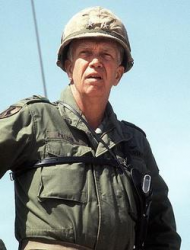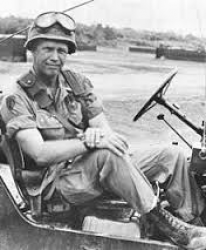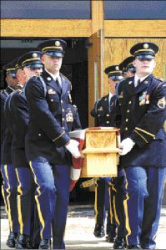
 |
|
|
||
|
George Smith Patton IV |
||||
|
Graduate, U.S. Military Academy, Class of 1946 Engagements: • Korean War (1950 - 1953)• Vietnam War (1960 - 1973) |
||||
| Biography: | ||||
|
George Smith Patton IV George Smith Patton IV was born on 24 December 1923, the son of famed World War II U.S. Army General George S. Patton Jr. He was in his last year at the U.S. Military Academy when his father died after a traffic accident in Germany in December 1945. Upon his graduation from the Academy in 1946, Patton was commissioned as a Second Lieutenant of Infantry. Second Lieutenant Patton's first assignment was to Regensburg, West Germany, where he participated in the 1948 Berlin Airlift. The troops under his command were used to load supplies onto Air Force transport aircraft bound for Berlin. Patton served in Korea starting in February 1953, commanding A Company, 140th Tank Battalion, 40th Infantry Division. Patton received his first Silver Star and the Purple Heart in Korea. Returning to the U.S. in 1954, Captain Patton was initially assigned to West Point but was quickly picked up as part of an exchange program and sent to teach at the U.S. Naval Academy. He served a total of three tours of duty in Vietnam. His first tour from April 1962 to April 1963, was at Military Assistance Command, Vietnam (MAC-V), where he was promoted to Lieutenant Colonel. He then commanded 2nd Medium Tank Battalion, 81st Armored Regiment, 1st Armored Division at Fort Hood, TX. Lieutenant Colonel Patton's second Vietnam deployment was in 1967 and lasted only three months. Patton's final, and most intense. tour lasted from January 1968 to January 1969. During that tour, he was awarded two Distinguished Service Crosses for his valor on the battlefield. During this final tour, he was initially assigned as Chief of Operations and Plans at Headquarters, U.S. Army Vietnam. However, following his promotion to Colonel in April 1968, he was given command of the 11th Armored Cavalry Regiment. Patton frequently used helicopters as a mobile command post in Vietnam and was shot down three times. He was awarded the Distinguished Flying Cross. Patton was promoted to Brigadier General in June 1970 and was appointed Commanding Officer, 2nd Armored Division, a unit his father had commanded in North Africa during World War II. This was the first time in U.S. Army history that a father and a son had both commanded the same division. The Abramses were the second to accomplish this feat. In 1972, BG Patton served as Deputy Post Commander at Fort Knox, KY. Known by the troops as a "GI General," Patton often appeared in A-2-3 Dining Hall during meal times. Often he would be helping on the serving line. As a Major General, Patton was assigned as Deputy Commander of VII Corps in Germany. He was stationed near Stuttgart, where Manfred Rommel, son of Field Marshal Erwin Rommel, was a government officer who later became the city's mayor. The sons of the two former adversaries met and entered into a much publicized friendship that continued until Patton's death in 2004. The men shared the same birthday, 24 December. MG Patton retired from the U.S. Army in 1980. Medals, Awards and Badges Distinguished Service Cross with Bronze Oak Leaf Cluster Distinguished Service Cross Citation (1st of 2 Awards) The President of the United States of America, authorized by Act of Congress, July 9, 1918 (amended by act of July 25, 1963), takes pleasure in presenting the Distinguished Service Cross to Colonel (Armor) George Smith Patton (ASN: 0-28685), United States Army, for extraordinary heroism in action in connection with military operations involving conflict with an armed hostile force in the Republic of Vietnam, while serving with Headquarters, 11th Armored Cavalry Regiment. Colonel Patton distinguished himself by exceptionally valorous actions on 5 September 1968 during a battle with a North Vietnamese Army force near Chanh Luu. From his command and control helicopter Colonel Patton saw a force of fifty-eight hostile soldiers attempting to escape his troops' encirclement. He immediately directed his door gunners to engage the communists and ordered his pilot to land in the vicinity of the enemy element. As the aircraft touched down it was damaged by an intense barrage of hostile fire from a deep, well concealed ravine. Aided by helicopter gunships, Colonel Patton led an assault against the North Vietnamese positions which forced the enemy to withdraw. A three-man rocket propelled grenade team remained behind to cover their retreat. When a platoon of infantry arrived to assist him, Colonel Patton led a squad into the ravine and directed an assault on the hostile position. During the fierce engagement Colonel Patton captured one of the aggressors, and the other two were killed as they tried to flee the ravine. Colonel Patton's extraordinary heroism and devotion to duty were in keeping with the highest traditions of the military service and reflect great credit upon himself, his unit, and the United States Army. General Orders: Headquarters, U.S. Army, Vietnam, General Orders No. 5468 (November 27, 1968) Distinguished Service Cross Citation (2nd of 2 Awards) The President of the United States of America, authorized by Act of Congress, July 9, 1918 (amended by act of July 25, 1963), takes pleasure in presenting a Bronze Oak Leaf Cluster in lieu of a Second Award of the Distinguished Service Cross to Colonel (Armor) George Smith Patton (ASN: 0-28685), United States Army, for extraordinary heroism in action in connection with military operations involving conflict with an armed hostile force in the Republic of Vietnam, while serving with Headquarters, 11th Armored Cavalry Regiment. Colonel Patton distinguished himself by exceptionally valorous actions on 24 September 1968 while directing a sweep around the village of Chanh Luu conducted jointly by the 36th Army of the Republic of Vietnam Rangers and Troop B of his 11th Armored Cavalry Regiment. Intense automatic weapons and rocket-propelled grenade fire from a house destroyed an assault vehicle and wounded several men, including the Rangers' commanding officer. Seeing that the Ranger unit was beginning to lose momentum, Colonel Patton had his command and control helicopter land in the middle of the embattled area and left the ship to rally the Vietnamese soldiers. Exposing himself to the hostile fire raking the area, he maneuvered them back to a supporting position near the enemy stronghold and directed his troops to more defensible terrain, while personally engaging the communists with his grenade launcher. He then led a charge which destroyed the house and revealed a heavily fortified bunker that had been concealed by the building. Ordering his men to lay down a base of fire, Colonel Patton crawled through the open terrain until he was at the fortification's entrance and hurled a grenade inside. When the enemy in the extensive and well protected bunker continued to resist, he assaulted a second time with two other men and placed TNT in the emplacement, annihilating the position. Colonel Patton's extraordinary heroism and devotion to duty were in keeping with the highest traditions of the military service and reflect great credit upon himself, his unit, and the United States Army. General Orders: Headquarters, U.S. Army, Vietnam, General Orders No. 839 (March 9, 1969) Silver Star Medal Citation (2nd of 2 Awards) The President of the United States of America, authorized by Act of Congress July 9, 1918 (amended by an act of July 25, 1963), takes pleasure in presenting a Bronze Oak Leaf Cluster in lieu of a Second Award of the Silver Star to Colonel (Armor) George Smith Patton (ASN: 0-28685), United States Army, for gallantry in action while engaged in military operations involving conflict with an armed hostile force on 9 August 1968 while serving as Commanding Officer, 11th Armored Cavalry Regiment in the Republic of Vietnam. On this date, elements of the 11th Armored Cavalry Regiment, assisted by the 1st Battalion, 8th Army of the Republic of Vietnam Regiment, were conducting a cordon and search operation in the village of Chanh Luu, Binh Duong Province. During the operation, the Army of the Republic of Vietnam troops performing the actual search encountered stubborn resistance by communist forces fighting from tunnels hidden under the village and progress was halted by hostile grenade attacks which inflicted a number of casualties upon the troops. At this time Colonel Patton intervened in the firefight, encouraging the Army of the Republic of Vietnam troops to continue their assault of the tunnel complex. Unable to find a fragmentation grenade, Colonel Patton obtained a smoke grenade from one of the Army of the Republic of Vietnam soldiers. Directing his Sergeant Major and S-2 to direct covering fire, Colonel Patton, totally disregarding his own personal safety, advanced upon the enemy position. As hostile forces attempted to launch another grenade attack from the tunnel entrance, Colonel Patton fully exposed himself to the full intensity of their fire, and threw the smoke grenade into the tunnel opening forcing the enemy force to break contact and enabling the friendly unit to secure the hostile position. Colonel Patton's courage and exceptional planning resulted in 16 communists killed and the capture of 99 Viet Cong suspects, one RPG-2 Rocket Launcher, 21 RPG-2 rocket rounds and numerous small arms and small arms ammunition. Colonel Patton's outstanding leadership abilities, unwavering devotion to duty and profound personal bravery while under hostile fire were in keeping with the highest traditions of the military service and reflect great credit upon himself, his unit, and the United States Army. General Orders: Headquarters, II Field Force Vietnam, General Orders No. 1224 (September 23, 1968) Post-Military Life In the years following his 1980 retirement from the Army, Patton turned an estate owned by his father (located north of Boston) into the 250-acre Green Meadows Farm. There he named the fields after soldiers who died under his command in Vietnam. In 1997, Patton worked alongside author Brian Sobel to write The Fighting Pattons, a book that served as an official family biography of his father, as well as a comparison between the military of his father's generation and that of his son; a time that covered five conflicts and almost 70 years of combined service. Death and Burial Major General George Smith Patton IV died on 27 June 2004 from a form of Parkinson's disease. He is interred at Arlington National Cemetery. His coffin is a simple pine box made by the sisters of the Abbey of Regina Laudis from trees grown on the property. His daughter, Margaret, was the Mother Superior of the Abbey. The insignia of the 2nd Armored Division and the 11th Armored Cavalry are inscribed on the coffin as well as the emblem of the cross. Also, the unit flags were placed inside prior to burial. (A photo of the coffin at his funeral is in the Photos section.) He was survived by his wife Joanne Holbrook Patton and their five children: Mother Margaret Georgina Patton OSB; George S. Patton V; Robert H. Patton; Helen Patton-Plusczyk; and Benjamin Wilson Patton. He was also survived by six grandchildren and a great-grandson. Youngest son, Ben, wrote a family biography entitled Growing Up Patton: Reflections on Heroes, History, and Family Wisdom, which reflected on his grandfather and father's careers. Family Patton was the fourth in his line to be named George Smith Patton. His great-grandfather, the first George Smith Patton, was a Colonel in the Confederate States Army during the American Civil War. He was killed in 1864 at the Battle of Opequon. Patton's grandfather, born George William Patton in 1856, changed his name to George Smith Patton in 1868, in honor of his father. He was the only one of the four not to serve in the military (although he, like the other three, attended the Virginia Military Institute). Patton's father was the renowned George Smith Patton, Jr., the World War II general most famous for his command of the Third US Army in Northwest Europe in 1944-45. Though given the name Junior, Patton's father was actually the third George Smith Patton. For this reason, Patton was christened George Patton IV. Following his father's death in 1945, Patton changed his legal name to George Smith Patton, dropping the Roman numerals. His eldest son, technically the fifth George Patton, is also known as George Smith Patton, Jr. General Patton's young grandson, who still is living, has given interviews on the History Channel and the Military Channel, recalling his family heritage. |
||||
| Honoree ID: 2950 | Created by: MHOH | |||
Ribbons
Medals
Badges
Honoree Photos
 |  |  |
 |  |
 |


